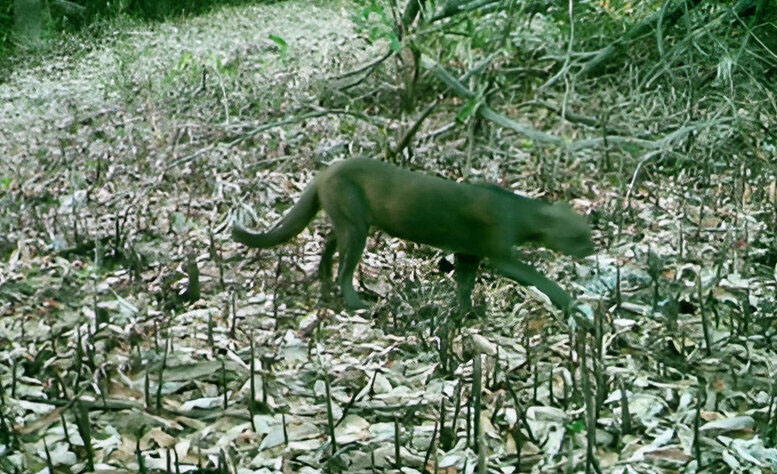Large and medium-sized mammals in Chismuyo Bay Honduras. A conservation alert: ¿what do model occupancy and detection tell us?
Main Article Content
Abstract
During the months of January and February 2018, a study was conducted using camera traps in the mangrove and tropical dry forest in Chismuyo Bay. The data obtained were analyzed to know the occupancy and detection probabilities of large and medium mammals along Chismuyo Bay, Honduras. Total sampling effort was 630 camera nights, with a record of 10 mammal species being: Herpailurus yagouaroundi, Canis latrans, Tamandua mexicana, Procyon lotor, Didelphis virginiana, Spilogale angustifrons, Sylvilagus floridanus, Odocoileus virginianus, Didelphis marsupialis and Mephitis macroura. The analyses indicate low occupancy (Ψ) and detection (p) for each of the species recorded in Chismuyo Bay, Gulf of Fonseca, Honduras. The populations of large and medium-sized mammals are in a critical situation, and it is urgent to take immediate conservation measures for their protection. Systematic monitoring should be established to provide a better perspective on the trends of large and medium-sized mammal populations in Chismuyo Bay.
Article Details

This work is licensed under a Creative Commons Attribution-NonCommercial-NoDerivatives 4.0 International License.
Revista Mexicana de Mastozoología, nueva época by Instituto de Ecología, UNAM. Distributed under a Licencia Creative Commons Atribución-NoComercial-CompartirIgual 4.0 Internacional.
Based on a work in: http://revistamexicanademastozoologia.com.mx/ojs/index.php/rmm.
Métricas de PLUMX
References
Baillie, J.E., M.G. Janine, S.T. Turvey, J. Loh. y B. Collen. 2010. Evolution Lost: Status and trends of the world’s vertebrates. Zoological Society of London. London, U. K.
Bodin, O. y J. Norberg. 2007. A network approach for analyzing spatially structured populations in fragmented landscape. Landscape Ecology 22:31–44.
Duncan, C.A., L.M. Chauvenet, L.M. McRae, y N. Pettorelli. 2012. Predicting the Future Impact of Droughts on Ungulate Populations in Arid and Semi-Arid Environments. PloS One 7:e51490.
Elvir-Valle, F.A., H.O.R, Portillo y L.E. Marineros-Sánchez. 2019. Distribución potencial y notas acerca del coyote (Canis latrans) en Honduras. Revista Mexicana de Mastozoología, nueva época, 9(1):20-30. ISSN: 2007-4484.www.revmexmastozoologia.unam.mx
Kadoya, T. 2009. Assessing functional connectivity using empirical data. Population Ecology 51:5–15.
MacKenzie, D.I.J., D. Nichols, G.B. Lachman, S. Droege, J.A. Royle y C.A. Langtimm. 2002. Estimating site occupancy rates when detection probabilities are less than one. Ecology 83:2248–2255 DOI 10.1890/0012-9658(2002)083[2248:ESORWD]2.0.CO;2.
MacKenzie, D.I.J., D. Nichols, J.E. Hines, M.G. Knutson y A.B. Franklin. 2003. Estimating site occupancy, colonization, and local extinction when a species is detected imperfectly. Ecology 84:2200–2207 DOI 10.1890/02-3090.
MacKenzie, D.I.J., D. Nichols, J.A. Royle, K.H. Pollock, L.L. Bailey y J.E. Hines. 2006. Occupancy estimation and modeling: inferring patterns and dynamics of species occurrence. San Diego, California: Elsevier.
MacKenzie, D.I.J y J.A. Royle. 2005. Designing occupancy studies: general advice and allocating survey effort. Journal of Applied Ecology 42:1105–1114 DOI 10.1111/j.1365-2664.2005.01098.x.
MacKenzie, D.I., M.E. Seamans, R.J. Gutierrez y J.D. Nichols. 2010. Investigating the population dynamics of California spotted owls without marked individuals. Journal of Ornithology 152:597–604 DOI 10.1007/s10336-010-0544-6.
Marineros, L. y F. Martínez. 1998. Guía de campo de los mamíferos de Honduras. Comunica. Tegucigalpa, Honduras.
Margules, C.R. y S. Sarkar. 2007. Systematic conservation planning. Cambridge University Press. Cambridge, U. K.
Martínez, W.E., R. Reyna-Hurtado, R. Naranjo, E. Thornton, D. Reynold y N. Figueroa. 2021. Occupancy rate and observations of Baird’s tapir (Tapirella bairdii) near waterholes in the Maya forest corridor, Belize. Revista Therya. Vol. 12, Num, 21. 37-43
Noon, B.R., L.L. Bailey, T.D. Sisk y K.S. McKelvey. 2012. Efficient species-level monitoring at the landscape scale. Conservation Biology 26:432–441 DOI 10.1111/j.1523-1739.2012.01855.x.
Instituto Nacional de Conservación y Desarrollo Forestal Áreas Protegidas y Vida Silvestre (ICF). 2015. Plan de Manejo del Sub-Sistema de Áreas Naturales Protegidas de la Zona Sur de Honduras 2015-2026.
Portillo, H. y F. Elvir. 2013. Composición, estructura y diversidad de los mamíferos terrestres grandes y medianos en 16 Áreas Protegidas en Honduras, usando fotocapturas como evidencia de registro. Mesoamericana, 17(2):15-31.
Royle, J.A. y J.D. Nichols. 2003. Estimating abundance from repeated presence absence data or point counts. Ecology, 84, 777–790
Saunders, D., R. Hobbs. y C. Margules. 1991. Biological consequences of ecosystems fragmentation: A review. Conservation Biology 5: 18-32.
Shannon, G.S., J. Lewis y D.B. Gerber. 2014. Recommended survey designs for occupancy modelling using motion-activated cameras: insights from empirical wildlife data. PeerJ 2:e532; DOI 10.7717/peerj.532
UICN. 2022. IUCN red list of threatened species. Version 2022-2. Retrieved from www.iucnredlist.org Accessed on Nov, 2023.

